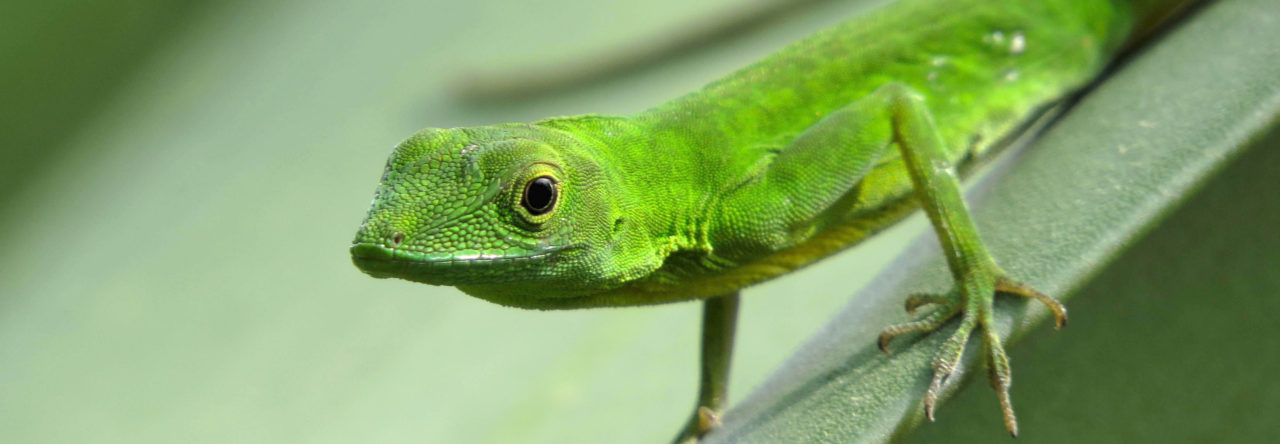Leo Fleishman and colleagues have just published a cool paper in Functional Ecology, “Why do Anolis dewlaps glow? An analysis of a translucent visual signal.” Co-author Manuel Leal provides the back-story on how the paper–which he refers to as “experimental natural history”–came to be in his lab’s blog, Chipojo lab.
And the New Scientist provides a nice summary of the article in its post: ”
Luminous lizard lotharios ahoy! In the dark undergrowth of the forest, it’s not easy to be seen. Male Anolis lizards use colourful throat fans, called dewlaps, to woo females as well as ward off rivals and predators. But one species has a neat trick to make itself stand out even more – it uses an optical illusion to make its dewlap appear to glow.
The dewlaps are translucent, which means they can transmit as well as reflect light. However, because most objects in the lizards’ environment – such as rocks and tree trunks – simply reflect light, our eyes “expect” them all to appear relatively dull. By transmitting light from the background, the dewlap tricks our eyes – and the eyes of other lizards – into thinking it is actually a light source, says Leo J. Fleishman of Union College in Schenectady, New York, who has studied the lizards for years.
Fleishman’s team was curious to find out why the trick evolved – was the glowing dewlap a way to increase contrast with darker backgrounds or a way to make its colour clearer?
To explore the issue, Fleishman’s team examined the photoreceptors in the lizard’s eyes to work out how they would view the dewlaps. They found that the glow did not create more contrast with the background, which naturally contains other bright spots – where a patch of sunlight passes through the vegetation, for instance. But the glow did significantly reduce the visual overlap, as the lizard’s eyes would experience it, between the throat fans and the colours of natural backgrounds.
The glowing dewlap may be more common than we think. Only a few of some 400 species of Anolis lizards are known to carry the trait, but Fleishman has seen photos suggesting other species’ dewlaps might glow too.
“My guess is that the phenomenon will turn out to be widespread once people start looking, but very few people have looked,” he says.
Here’s the paper’s summary:
Summary
- Male anoline lizards utilize a colourful, expandable throat fan, called the dewlap, to rapidly and unambiguously signal their presence and species identity to conspecifics. Under some viewing conditions, the dewlaps of some species appear to glow vividly, because they transmit a great deal of diffuse light, creating a translucent signal. Translucent signals are probably found in many animal groups, but they have rarely been studied.
- We hypothesized that dewlap translucence might (i) increase dewlap/background luminance contrast or (ii) increase the reliability of the colour as a species recognition signal by lowering the colour discrimination threshold in low light conditions such as forest shade.
- We calculated dewlap colour (spectral radiance) for the Jamaican lizard Anolis lineatopus at natural perch sites with, and without, the inclusion of transmitted light.
- Transmitted light did not significantly increase the magnitude of luminance contrast between the dewlap and background.
- We plotted colours of dewlaps, background patches of habitat and dewlaps of sympatric species in an anoline perceptual colour space (the colour tetrahedron), based on the four classes of cone photoreceptors found in the retina. Using a newly developed approach, we used ellipsoidal plots of uncertainty to quantify perceptual overlap between dewlap spectral radiance and values for natural distractor colours. Diffuse transmission of light through the dewlap greatly reduced the perceptual overlap between the dewlap and natural background colours.
- This finding strongly suggests that selection has favoured the evolution of a translucent dewlap as a mechanism to increase the reliability of detection of the signal under the low light conditions. In general, any animal’s colour signal must emit sufficient light intensity to allow the colour to be discriminated from other distractor colours in the habitat. This will tend to favour the evolution of colours with higher total intensity (i.e. higher reflectance and/or transmittance) in animals that signal in relatively low light conditions such as forest shade.
- Evolution in Real Time on Lizard Island - March 23, 2025
- Spider Snags Adult Anolis osa - March 22, 2025
- An Homage to the Green Anoles of New Orleans - March 21, 2025


Skip Lazell
Nifty! Really glad to read this! Thanks, Skip